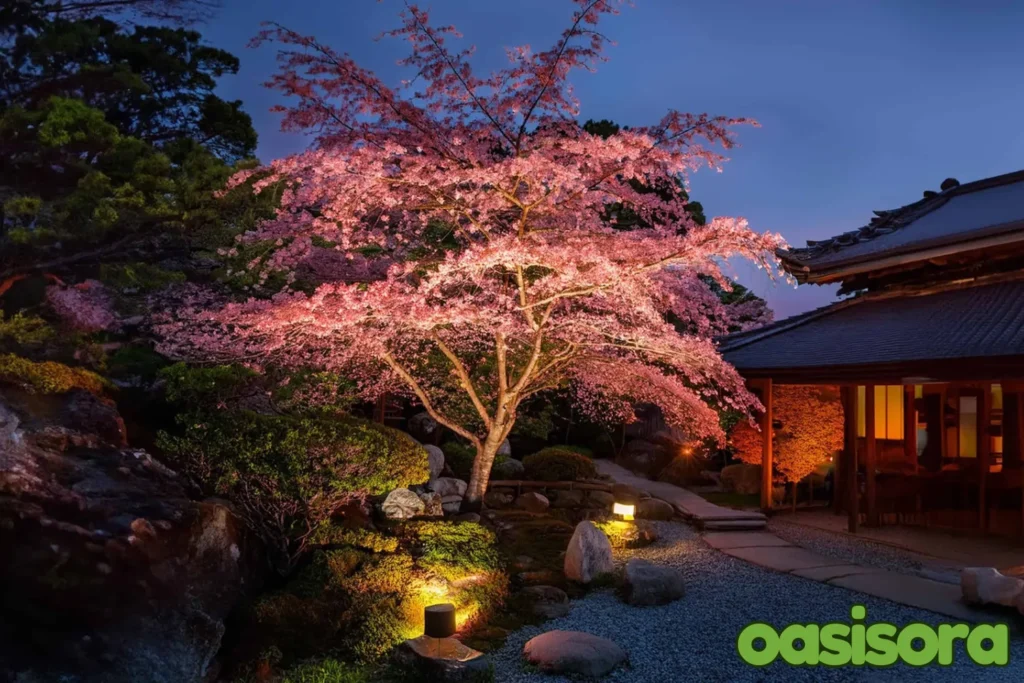
Thoughtful lighting can extend the peaceful beauty of a Japanese Zen garden well into the night. With the right fixtures, you can highlight textures, guide pathways, and enhance the tranquil ambiance after sunset. But behind that peaceful aspect, much dedication, such as pruning, cutting, and diligent care, are essential for preserving a Zen garden’s elegance. But what’s the purpose of all that effort if this beauty hides in the darkness of night?.
Applying well-designed Japanese Zen garden lighting ideas might offer it life at night, letting you appreciate its beauty even in the dark. Lights set thoughtfully can create fascinating contrasts, highlighting trees while creating soft, mystery shadows. This post will look at a few fundamental strategies for effectively lighting your Zen garden.
TL;DR:
Quick Zen Garden Lighting Tips
- Zen garden lighting promotes night splendor while staying modest, centered on creating light pools between shadows.
- Merge classic components like stone lanterns with innovative technology like mild LED or solar lights.
- Promote key elements (rocks, water, trees) and plan for specific lighting changes to enjoy each season.
- Seek a balance between beauty and functionality: design carefully, focus on DIY options, and update your lighting system consistently.
Understanding the Essentials of Japanese Zen Garden Lighting
Zen gardens utilize the same basic planning and installation rules as lighting for the outdoors.
Before we proceed into the technical details of Zen garden lighting, I suggest the following steps:
- Draw a precise Framework of your Zen garden, containing structures, Japanese plants, and architecture. Check to place the garden in the setting of your home, as you may need to apply to reachable exterior sources of power for your lighting equipment.
- Select which places (e.g., pathways) along with particular elements (e.g., a prominent tree) you’d like to illuminate and what form of lighting can operate best for each.
- Avoid utilizing unnecessary illumination and try to make pools of light in the middle of silence and dark.
- Before you settle your lighting setup, examine your best estimate for installation costs and labor. Some outdoor garden lighting methods fit themselves to quick DIY projects, while others involve a professional electrician for perfect safety.
Zen gardens embody simplicity and sustainability, making energy-saving lighting essential for a eco-friendly Zen garden.
LED lights are low-energy and durable, while solar-powered lights offer renewable, wire-free brightness of paths and features.
Both approaches are perfect for balancing sustainability and harmonious beauty.
Reliable outside lighting is required for Zen gardens. Pick weather-resistant fixtures such as metallic stainless steel or coated aluminum, and be sure they have a high IP rating to safeguard against water and dust. It enables long-term performance in all weather.
Zen garden lighting has to cope with all seasons. Choose closed fittings to protect internal components from rain and debris, and ground-mounted lights with solid support to ensure safety in severe conditions. This guarantees stable illumination all year round.
Strategic Light Placement
Tactful Light Placement shows a clear picture of every feature of your zen garden. It’s not just installing a lantern in one particular spot, but it is a thorough analysis of these gardens’ characteristics:
- Central Points: Installing lights in your zen space captures attention on major components such as systematically set rocks, a smooth surface of dense moss, or a flat curve of a raked gravel structure. A gentle glow can highlight these features beautifully after sunset.
- Pathways: preserving the garden’s peaceful environment while offering a secure and enjoyable route. Paths with dim illumination can quietly mark borders and inspire a sense of journey.
- Vertical Elements: By arranging gentle lighting on bamboo stems or trees, you can generate prominent figures and give the garden a sense of depth, converting ordinary objects into attractive forms.
- Water Features: Proper and harmonized lighting with your space’s environment can produce glowing reflections and enhance the calming sound of water in a small pond or water basin. Submerged lighting is another style to achieve a pleasant effect.
Balancing Light and Shadow
The connection between weaving light and dark is vital. It clarifies all the objects in the Zen garden along increasing its elegance. Instead of just overloading the garden with light, look into the following:
- Creating Contrast: By enabling shadowed regions to thrive with bright spots, you can add attention to detail and an atmosphere of broadness and mystery. Suitable contrasts highlight the style and decor of your Japanese garden.
- Evoking Mood: While strategically placed lights reflect attention and create focal points, soft, indirect lighting usually promotes a quiet and reflective mood.
- Taking Time into Account: During the day and night, the association between light and shadow will continually change. The way artificial light may imitate or strengthen these organic changes is carefully considered in insightful lighting design.
Thus, the lighting system must show off the garden’s distinctive characteristics without dominating its simple beauty while helping to achieve a harmonious balance.
9 Japanese Zen Garden Lighting Ideas for Every Style
Brighten your Japanese Zen garden with lighting systems that balance elegance and functionality. Create a relaxing mood that suits any decor by using soothing pathway lights and contrasting essential features.
Let’s discuss top lighting ideas in detail:
1. Embracing Traditional Japanese Lanterns
Ishi-dōrō lanterns, or stone lanterns, may be the most apparent item in a zen garden. While these lanterns are often aesthetic components found in trendy zen gardens, they can be turned into active lighting elements by adding candles or self-contained LED lights internally.
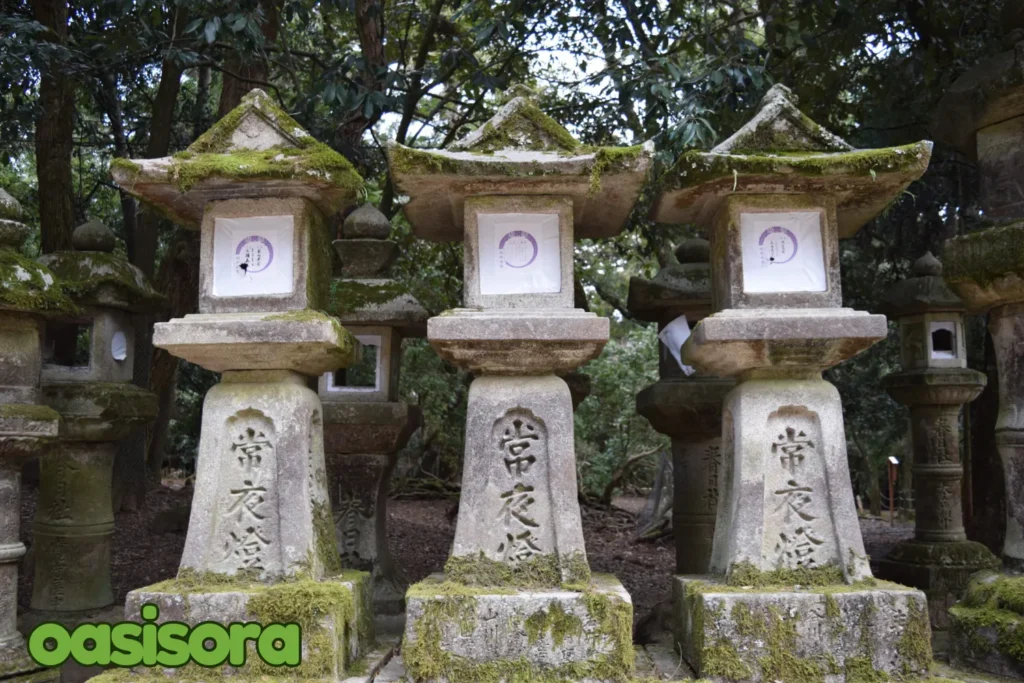
Ishi-doro lanterns
Stone lantern arrangement plays a vital role in Japanese gardens. They should be placed at strategic locations such as garden gates, areas with water features, and pathways.
Yet a candlelight stone lantern enhances the zen garden lighting in an authentic way.
You can buy impressive stone lanterns on the web or at your nearby landscape resource store, but be careful: they can be costly!
Andon lanterns are a classical Zen garden lighting of a unique type. Traditionally, they were created out of bamboo frames and paper walls while set on the ground to illuminate the internal spaces of buildings and houses.
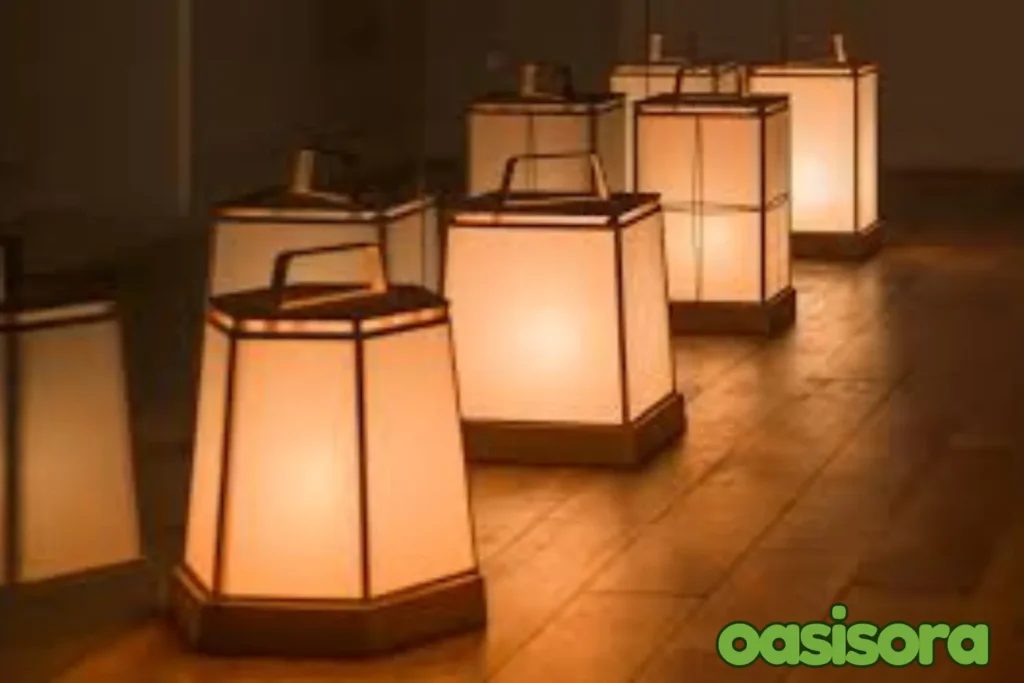
Andon lanterns
Many modern versions of traditional Andon lanterns are built for outdoor use. Their portable design and classic appearance make them perfect lighting solutions for Zen garden admirers.
Chōchin lanterns are the ultimate version of traditional zen garden lighting on this list of items. They are usually made from a lightweight elastic frame with a coated paper covering.
These lights often hang from the exterior of buildings and trees.
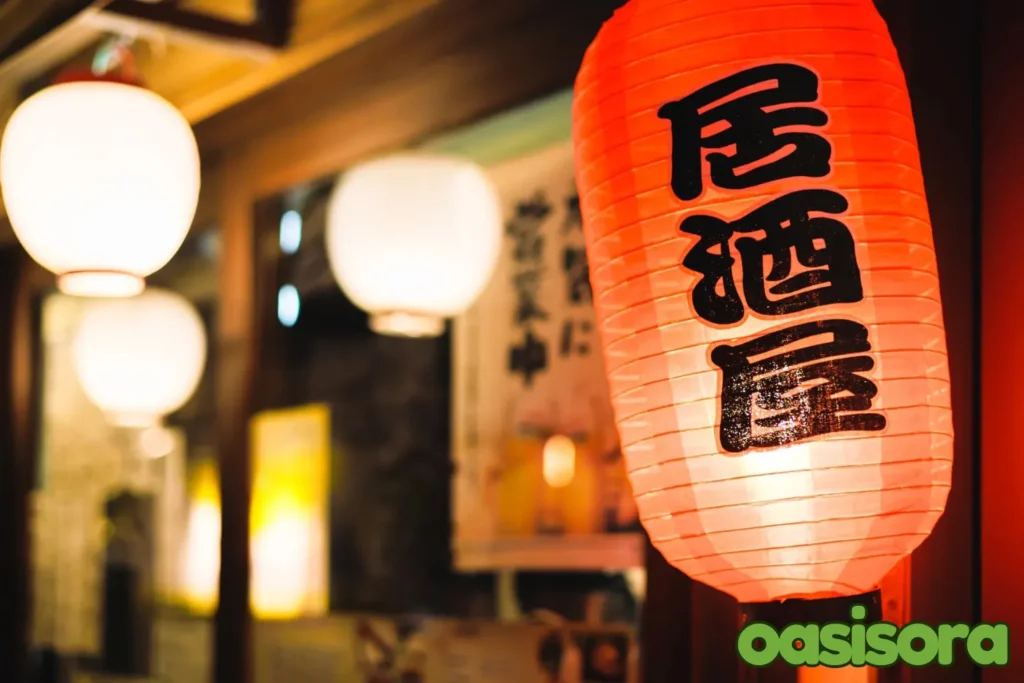
Chochin lanterns
They’re suitable for short or festive displays and can be safely lit with battery-powered LED candles.
2. Modern LED Lighting Techniques for Zen Gardens
LED lighting methods and affordable Japanese Zen garden lighting ideas are relatively easy to set up.
Some of the LED lighting selections available are solo bulbs, strip lights, and lights of various colors.
Most lights are self-sufficient, which means they run on batteries or solar energy sources and do not require a separate source of power.
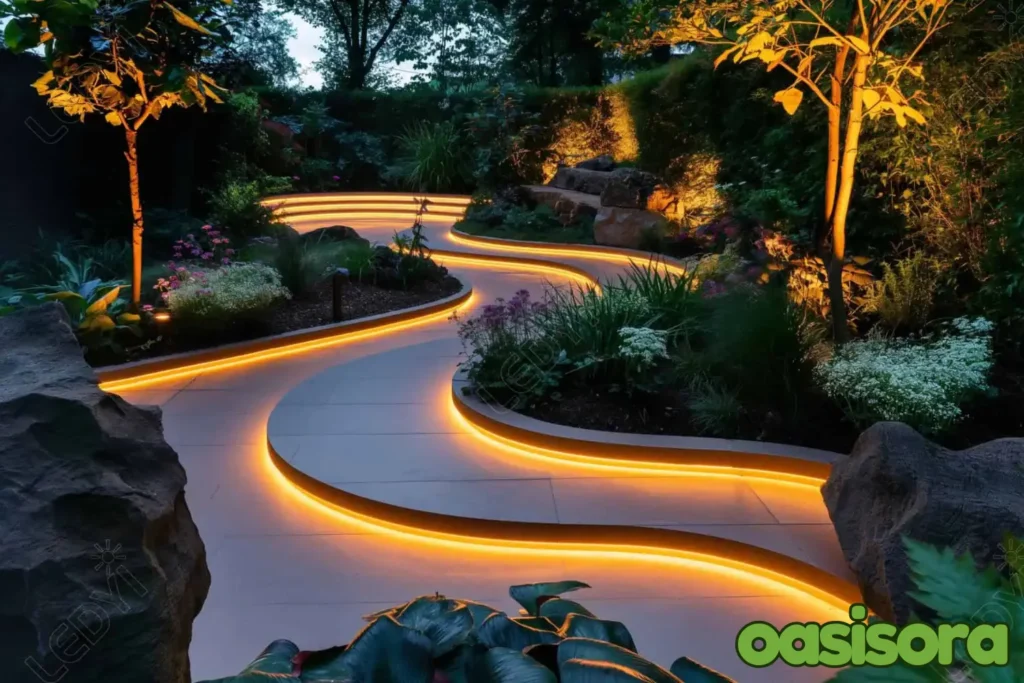
Modern LED Lighting for Zen Gardens
To keep your Zen garden in precise balance, go with hidden LED lights that offer a mild, natural glow.
Avoid using heavily bright white or colorful LEDs because they will distract from the relaxed atmosphere of your landscape.
Solar-powered lighting is a further great option for your Zen garden. Most solar-powered light is LED, so look for ways that provide soothing natural lighting.
Smart lighting is any type of lighting option that can be managed via an app on your tablet or phone.
LEDs are among the simplest kinds of smart lighting, and they usually provide a variety of levels of light and color schemes.
Low-voltage lighting techniques were used for outdoor lighting before LEDs.
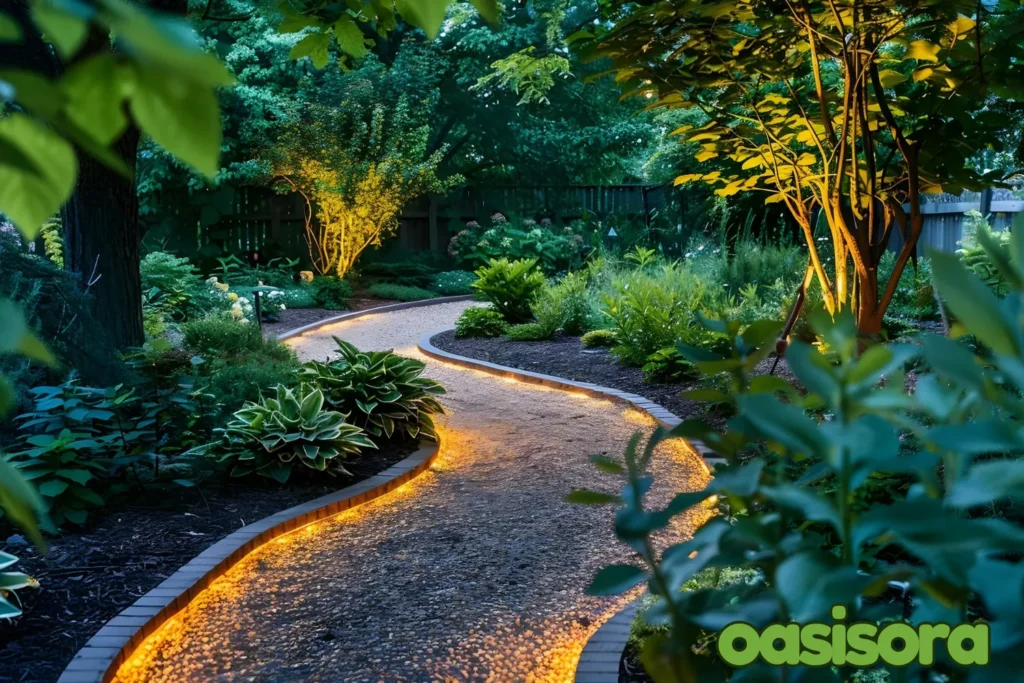
Low-voltage lighting for Zen garden
Such lighting systems are connected to your home’s power by an exterior-mounted transformer, which reduces the voltage of the power source. Digging and connecting electrical lines, as well as the transformers, are sometimes necessary during installation. Consider hiring an expert electrician to assist you with your lighting layout and setup.
Bonsai tree designs for lighting and narrow-beam lights display beneficial plants such as Japanese maples and properly trimmed bonsai. For larger trees, try maple tree illuminating techniques.
Adding small, hidden lights to moss garden night lights provides a smooth, magical glow.
3. Accentuating Pathways and Walkways
Soft, low-level lighting is necessary to illuminate the paths and walkways of your Zen landscape harmonizing safety and elegance.
It gently brightens the paths, boosting visibility at night and lowering the risk of slipping and falling. Soothing lighting provides a relaxing glow, showcasing the natural textures of stones and plants and guiding visitors through the garden.
To achieve this, mount lights at regular intervals for even lighting, position them at a low height to decrease glare, and use styles such as classic lanterns or modern LED bulbs to fit your garden’s decor. Solar lights are also useful for generating path illumination. This method favors a peaceful and enjoyable atmosphere.
I support mild, natural Japanese Zen garden lighting ideas like soft red and orange light may be great choices.
4. Highlighting Water Features with Gentle Illumination
Japanese Zen garden lighting ideas for Koi ponds, streams, and waterfalls provide a dazzling impression from the inside. Use flashlights to enhance the movement of water in fountains and waterfalls. Think about using color-changing lights to create a stunning nighttime water display.
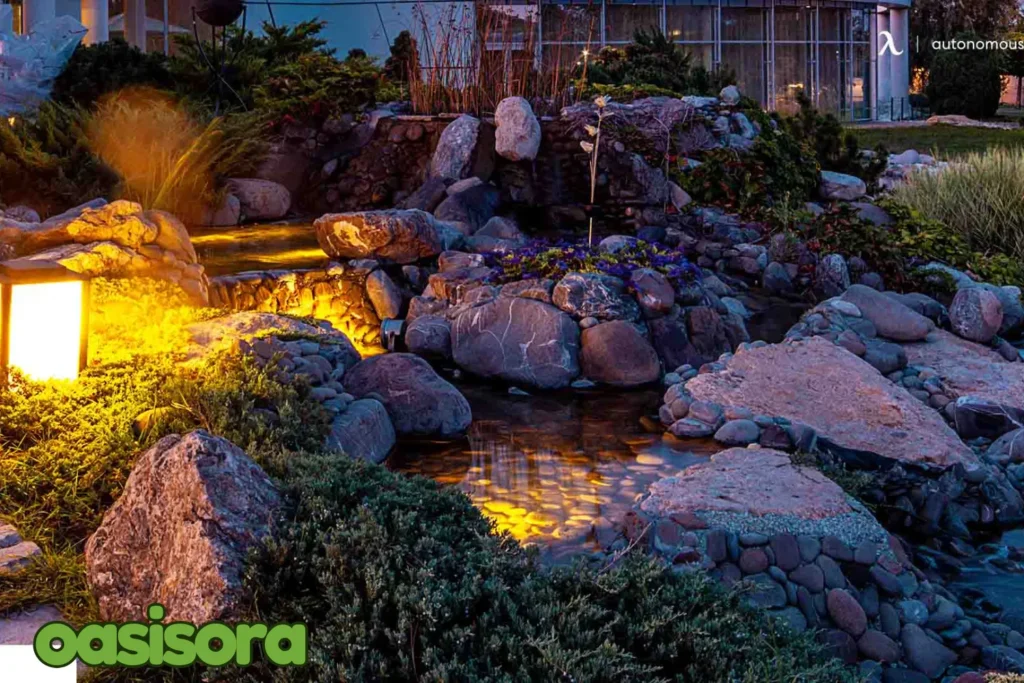
Water Features with Gentle Illumination
You should look for underwater LED lights to create a soft glow in ponds, which will improve fish movement and color. Set spotlights at an angle on fountains or waterfalls to draw focus on the flowing water and texture.
Let’s analyze the key concepts about pointing out water features with soft lighting through the use of water and reflections:
- Stone Lantern Reflections: A conventional lantern yields a permanent, raised visual effect when set next to still water.
- Moonlight Simulation: Producing a natural moonlight effect with gently positioned white lights may boost peacefulness through soft reflections.
- Emphasizing Movement: when a soft glow hits rushing water like trickles, waterfalls, it forms variable and eye-catching sparkling reflections.
- Consider the Surface of the Water: whether it is still or moving, the water’s top layer determines the visibility and form of the reflected images.
- Water as an Active Element: The water itself serves as an essential element of the lighting scheme, functioning in combination with thoughtfully positioned soft lighting to produce an appealing and fascinating focal point.
5. Creating Depth and Dimension with Shadows
Zen gardens are known for their unique features like rocks, stone lanterns, and beautifully shaped trees and bushes.
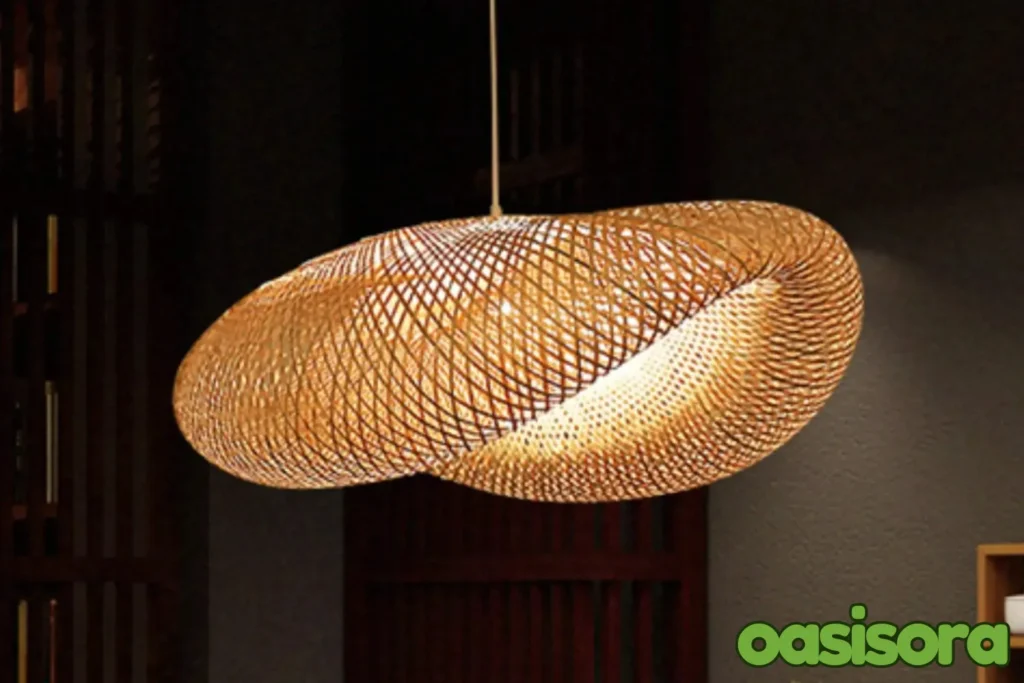
Hanging bamboo pendants
After dark, outdoor lighting may show off as well as enhance these features. Try to develop pools of light that move your attention from one component to the other.
You should avoid the steady lighting of the entire garden.
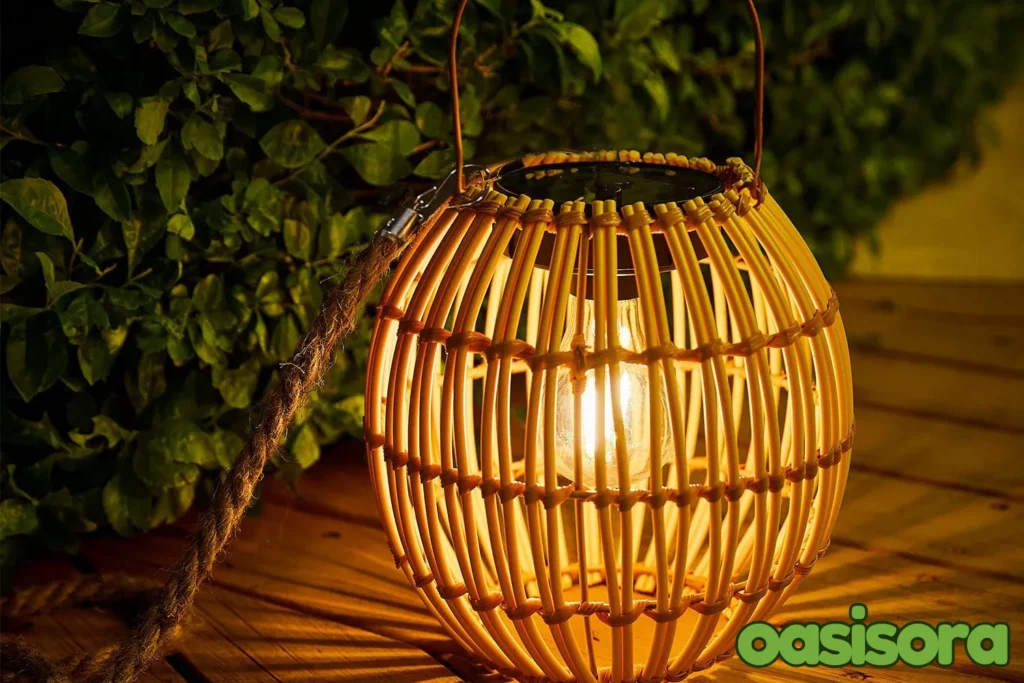
Bamboo lantern
Rock garden light can produce significant shadows and highlight structures on objects and stones. To highlight the true colors of stones try with colored lights, or use wash lighting for bigger rock patterns.
Uplighting and downlighting present flair to your landscape. Install uplights at the base of trees for an eye-catching appearance, while downlighting in trees may give a natural moonlight look to your space. Shadow play in Japanese gardens contributes a distinctive richness to the night environment.
Set lights to produce amazing shadows on plants or structures, or use glowing backlighting to make beautiful shadow patterns on plants or decorative items.
6. Choosing the Perfect Color Temperature
Warm and cool light in Zen areas may deliver you a variety of atmospheres.
Warm lights (2700-3000K) build a cozy, friendly atmosphere resembling candlelight or a setting sun. They’re optimal for peaceful spaces or focusing warm-toned objects in your garden.
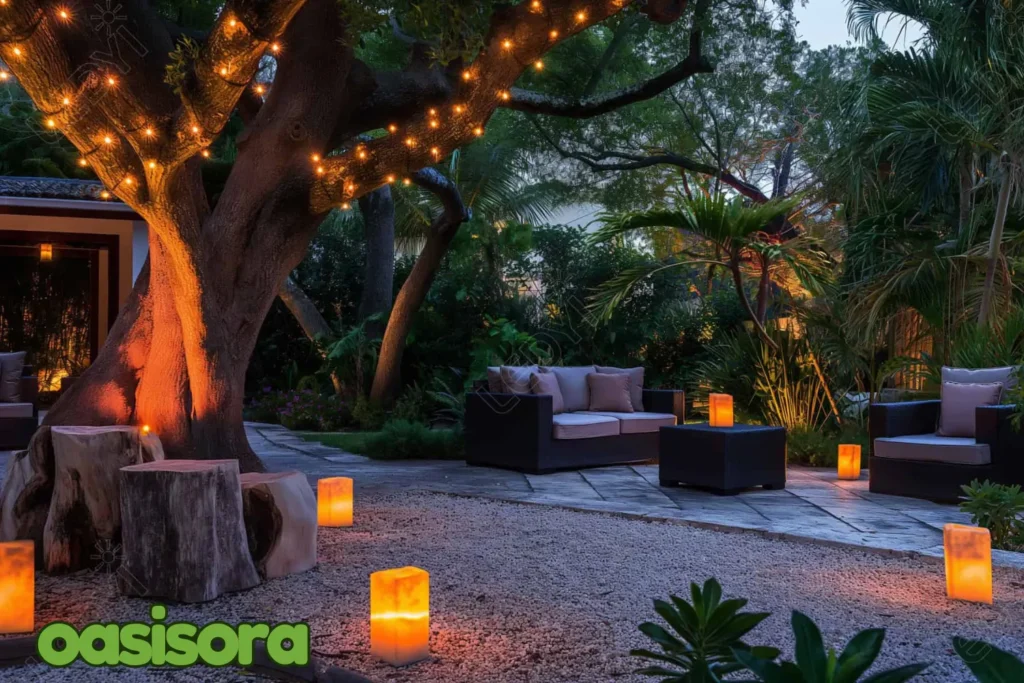
Warm lights for zen garden
Cool lights (5000-6500K) represent moonlight while providing an attractive appearance. They can be exciting and are fantastic for highlighting water features or establishing a peaceful, moonlight environment for you. Consider the color temperature when implementing Japanese Zen garden lighting ideas.
I favor warm lighting because most outdoor lighting alternatives do not effectively replicate the distinctive characteristics of moonlight.
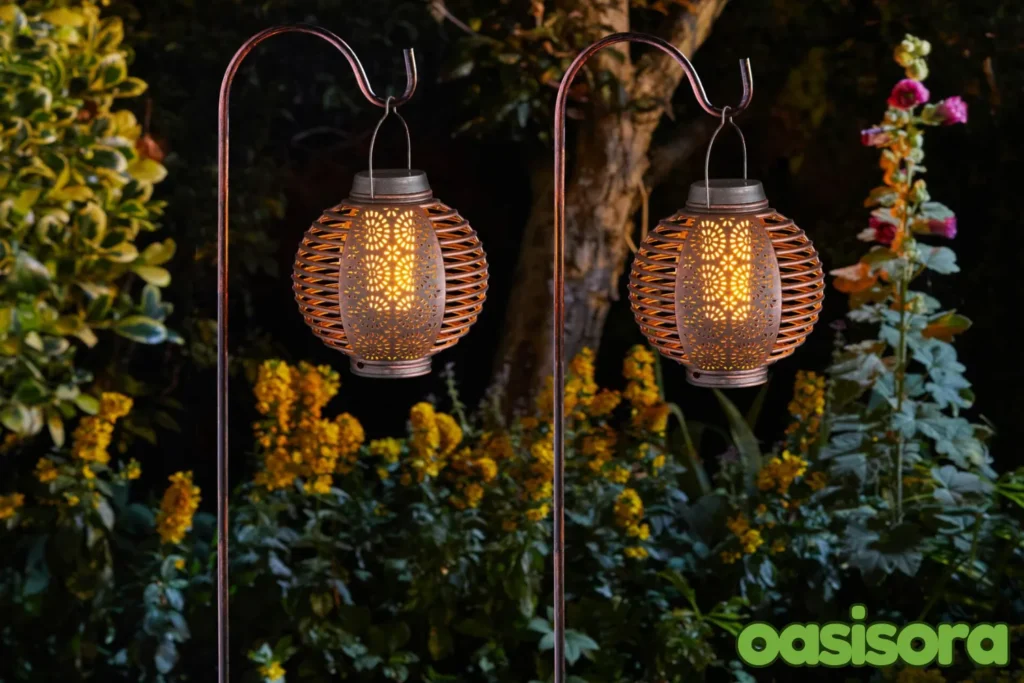
Cool hanging lights for zen garden
7. Seasonal Lighting for Year-Round Serenity
DIY Japanese lantern crafts can be made from rice paper and bamboo frames to produce traditional chōchin lanterns in various shapes and sizes.
For a final touch of reliability, you can look into applying calligraphy or nature-inspired themes.
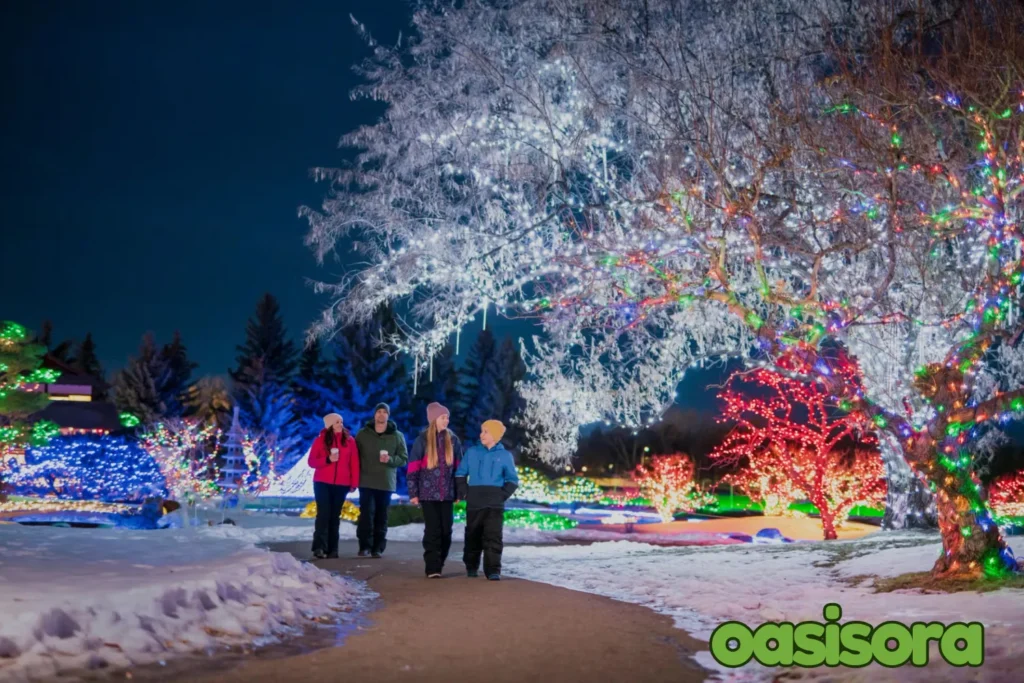
Seasonal lighting
Cool-toned lights are wonderful to generate a refreshing atmosphere during the summer. Brighten your gathering spots with these lights for nighttime entertainment. Autumn light should bring out the lovely fall landscape. Pleasant amber lighting may serve you to create a warm and inviting decor. Enhance the fluctuating colors of Japanese maples and seasonal plants in your yard.
Winterproof garden lights effectively change your outdoor area into a quiet imaginary world. Uplighting on evergreen plants throws shocking shadows on the snow-covered land.
Use weatherproof light bulbs in open places, raise the surface lights to prevent snow storage, and select lighting substitutes designed for high temperatures.
Important Note: When updating your Japanese Zen garden lighting ideas for the seasons, think about installing a smart lighting system that lets you modify color schemes and lighting patterns.
It enables you to easily change your garden’s vibe throughout the year while reducing the need for material changes to your lighting structure.
8. Solar-Powered Lighting for Eco-Friendly Elegance
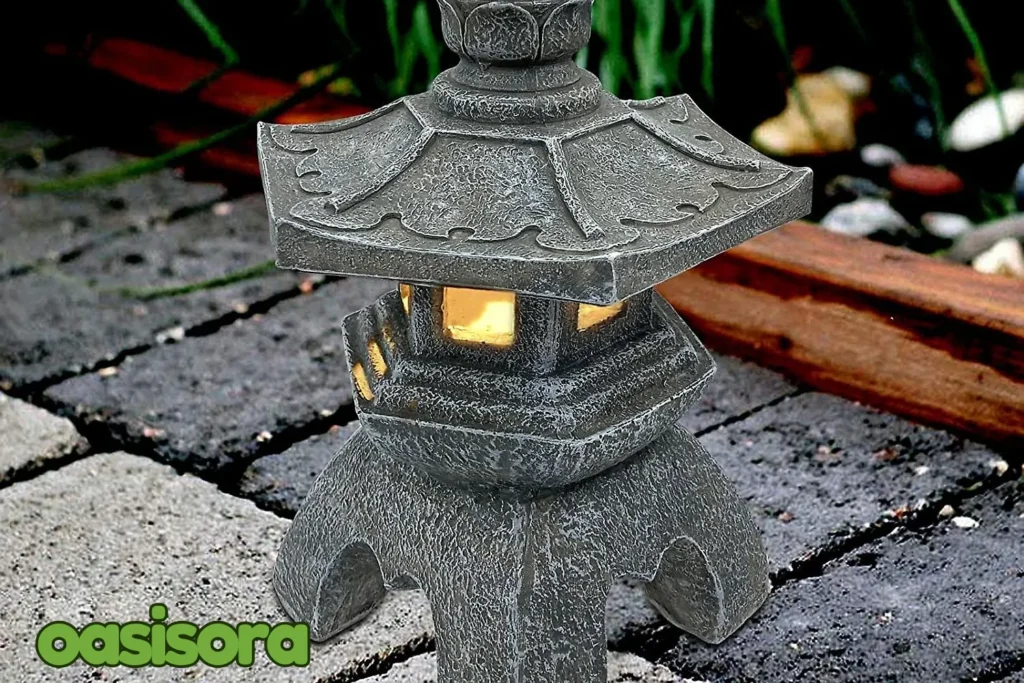
Solar rock lantern
Solar lighting arrangements require easy setup and a sustainable way to improve the appearance of your Zen garden at night. These lights use solar energy all day, eliminating the need for wiring or power and giving a soft, natural glow at night.
It not only lowers your carbon effect, but it also offers affordable maintenance and minimizes future expenses. Solar-powered lights are suitable for illuminating paths and emphasizing garden parts, as they adjust smoothly with the natural surroundings, sustaining your Zen garden’s quiet and peaceful decor.
Their versatility and sustainable layout provide an excellent option for optimizing beauty and functionality.
9. DIY Lighting Projects to Personalize Your Garden
Landscape decor materials typically have a significant environmental impact. When building a sustainable zen garden, using locally sustainable supplies for walkways and borders is essential.
Upcycled Japanese garden lights can be made out of ordinary items. Old glass bottles can be modified into hanging lanterns, bamboo kitchenware into fascinating light covers, and retrieved wood is helpful in creating traditional lamp poles for your Japanese garden area. Make a bamboo torch utilizing a hollow bamboo pole and an LED lamp, a bamboo cage for holding candles or lights, or a bamboo base lamp with multiple parts to adjust height.
Point to Remember: Remember that, as per Zen philosophy, beauty can be found in the sake of simplicity and variation.
Allow your Japanese Zen garden lighting ideas to express this concept for a genuine, authentic Zen garden experience.
Maintaining and Caring for Your Zen Garden Lighting
You should follow the following measures for the upkeep of your zen garden illumination arrangement:
Regular cleaning of lighting components must be done for peak performance. Clean the transparency and plastic cover for maximum light output; even a small layer of dust can significantly disrupt functionality.
Keep the solar panels clean and dust-free to ensure solar-powered lights charge effectively.
Plant maintenance surrounding lighting components minimizes excess and unfavorable shadowing. The pruning of Japanese plants regularly helps to keep lights free of hazards and working correctly.
Fixing common lighting issues timely can save you both time and stress. Check connections periodically, repair damaged lights or fuses, and examine wiring for damage due to weather or animals, especially after storms or in active wildlife zones.
Regular battery inspections for battery-powered lights are necessary. Examine and repair batteries to maintain consistent performance throughout the season.
Weatherproofing expands the functioning of your lighting system. Apply a silicone coating to electrical connections to prevent moisture, use anti-rust materials for uncovered fixtures, and raise lights on slightly higher points for better drainage.
Helpful Tip: Plan a maintenance schedule for your Zen garden lighting. Regular maintenance promotes peak performance and aids in detecting possible faults before they become serious problems.
This proactive strategy will enhance your garden year-round, retaining its serene mood regardless of the season or weather conditions.
Final Thoughts
Illuminate the Peace in Your Zen Garden
Modest Japanese Zen garden lighting ideas enhance its aesthetic value and offer a magical, mystical environment after dark.
Follow Zen’s primary notion of minimalism while picking essential LED lights or a low-voltage external arrangement.
Refrain from overlighting and highlight key features such as stones, trees, or sculptures.
Smart lighting does more than just increase the garden’s hours. It provides a peaceful setting for reflective thinking, relaxation, and even nighttime meditation.
Each light and shadow interact to impart a sense of quiet and tranquility, making your Zen garden a wonderfully pleasant refuge at every moment.
FAQs
How to light a Japanese garden?
Create a calm atmosphere through splendid Japanese Zen garden lighting ideas. Use stone lamps, soft LEDs, or solar-powered lights to show off significant features involving paths, trees, and water components.
What are the Zen principles of Japanese garden design?
Zen emphasizes minimal design, authenticity, and a stable state. They use simplicity, unevenness, and consistency with nature to create a space for reflection and calm.
What is a Japanese garden lamp called?
A Japanese garden lamp termed an ishi-dōrō (stone lantern), is often utilized to illuminate paths or significant attractions. Additional types are Andon and Chōchin lanterns.
What are the five elements of a Japanese garden?
The five elements are rocks, plant life, water features, bridges, and lighting devices, which display nature, balance, and harmony.

8 thoughts on “9 Modern Japanese Zen Garden Lighting Ideas for Your Home”
Comments are closed.